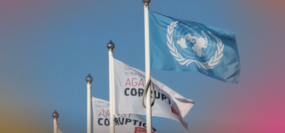Posted on 19 Mar 2024
The UN Security Council (UNSC) continues to track the detrimental role that organized crime, illicit flows and markets, and criminal actors are playing in conflict zones.
We initially analyzed all UNSC resolutions from 2000 to 2017, and coded them for references to any form(s) of organized crime discussed in the resolution. Since 2017, the material has been updated annually.
The research found that, in 2024, 52 per cent of Security Council resolutions mentioned one of the crime types tracked by the tool. This is the third year in a row that more than half of the resolutions have done so. Arms trafficking, financial crimes, kidnapping and human trafficking were the most frequently mentioned crimes in 2024, in line with previous years. Crimes that affect the environment, including resource exploitation and wildlife trafficking, were also frequently referenced in contexts of conflict and instability. It is worth noting that the number of resolutions adopted by the Council as a whole continued to decline in 2024, by around 20 per cent compared to 2021 and 2020 – as a result of vetoes by permanent Council members and the inability of members to secure sufficient votes. However, fewer resolutions have not resulted in less attention by the Council to the impact of criminal markets on instability and conflict around the world.
We created the data visualization below to allow you to explore our data yourselves. Search by region, country, or crime type – or the intersection between them. Click on the bars for active links back to the original resolutions.
Charting Organized Crime and Illicit Flows at the Security Council: An Interactive Tool
Methodology
A team of researchers coded all resolutions from 1 January 2000 to 31 December 2017, totalling 1 113 resolutions. All resolutions passed by the UNSC since 1946 can be found by clicking here. Resolutions from before the year 2000 were not used in this study. The research is now updated on an annual basis on this page.
Incidents of organized crime mentioned in UNSC resolutions were broken down by the type of crime. In many cases, resolutions would imply an incident of organized crime, such as human trafficking, but not explicitly label the incident as such. In recognition that these omissions are often the result of political influence and that the acknowledgement of crime carries significant implications, researchers made an informed judgement call on whether to include certain incidents based on the wording in the resolution, and on its applicability to the current UN definition of the crime type (as of 2017). For example, the recruitment and use of child soldiers is labelled as human trafficking in this interactive tool. The Council itself has expanded the way it refers to organized crime, using terms including transnational organized crime, illicit networks, transnational networks, trafficking networks, gangs, and criminal governance. To locate these incidents of organized crime, search terms were used to thoroughly scan each resolution.
UNSC resolutions often begin by referencing relevant previous resolutions. In these instances, the content of the referenced resolutions was not included as part of the resolution under consideration. For example, if a resolution in 2017 referenced a resolution from 2005 that affirmed the UN’s position on human rights, and the resolution from 2005 mentioned human trafficking, the mention of human trafficking was recorded in 2005, and not as part of the resolution in 2017. This was done to avoid duplication in the dataset.
Acknowledgements
This data visualisation was created by a team from the Global Initiative against Transnational Organized Crime, led by Tuesday Reitano and Mark Shaw. Data was collected and coded by Kristen Olver, Alexandre Bish, and Anna Rosenberg. The application was designed by Original Content London.
We encourage you to use our tool for analysis and visualisation, and feel free to share it widely. You can also download the original source data.
We do, however, appreciate a citation or acknowledgement, as the following:
Global Initiative Against Transnational Organized Crime, 2018, Organized Crime and Illicit Flows at the Security Council,
www.globalinitiative.net/SCResolutions.
The data will be updated on an annual basis.



